Rajasthan Board RBSE Class 11 Maths Chapter 4 Principle of Mathematical Induction Ex 4.1
Question 1.
If statement is P(n) : (n + 3) < 2n+3 then write P(4).
Solution:
P(n) : (n + 3) < 2n+3
Putting n = 4
P(4) : (4 + 3) < 24+3
P(4) : 7 < 27
P(4) : 7 < 128 is true
Hence, P(4) : 7 < 27.
Question 2.
If statement

then test the authenticity of P(4).
Solution:
Let the given statement is P(n), where n ∈ N
So, P(n) = 12 + 32 + 52 + … +(2n – 1)2
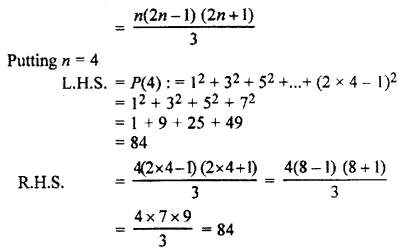
L.H.S. = R.H.S.
Hence, P(4) is true.
Question 3.
Write nth term of 1 + (1 + 3) + (1 + 3 + 5) + …….
Solution:
1 + (1+ 3) + (1 + 3 + 5)+…….
= 1 + (1 + 3) + (1 + 3 + 5) + ……. + {1 + 3 + 5 + … +(2n – 1)}
Tn = a + (n – 1)d = 1 + (n – 1)2 = 1 + 2n – 2
Tn = 2n – 1
Hence, nth term = 1 + 3 + 5 + … + (2n – 1).
Question 4.
Write nth term of 1.4.7 + 2.5.8 + 3.6.9 + …….
Solution:
nth term of 1.4.7 + 2.5.8 + 3.6.9 + …….
= (nth term of 1, 2, 3, …).(nth term of 4, 5, 6, …).(nth term of 7, 8, 9, …)
= [1 + (n – 1) – 1].[4 + (n – 1) – 1].[7 + (n – 1)1]
= (1 + n – 1) . (4 + n – 1) . (7 + n – 1).
= n (n + 3) . (n + 6)
Hence, nth term = n.(n + 3).(n + 6).
For all n ∈ N, by using principle of mathematical induction, then prove that: (Q. 5. to Q. 19)
Question 5.
1 + 3 + …… + (2n – 1) = n2.
Solution:
Let the given statement is P(n) where n ∈ N
P(n) : 1 + 3 + … + (2n – 1) = n2
when n = 1, P(1) = 1 = 12 = 1
Hence given statement is true for n = 1.
So, P(1) is true
Let given statement is true for n = m i.e.,
P(m) = 1 + 3 + … + (2m – 1) = m2 …(i)
Now, we have to prove that given statement is true for n = m + 1, i.e., P (m + 1) is true.
Now, P(m + 1) = 1 + 3 + …… + {2(m + 1) – 1}
= (m + 1 )2
= 1 + 3 + … + (\(\bar { 2m+1 }\) – 1)
= (m + 1)2
Hence, given statement is also true for n = m + 1 i.e., P (m + 1) is true.
Hence, from the principle of mathematical induction we can say that the given statement is true for each natural number n ∈ N
Hence Proved.
Question 6.
1 + 4 + … + (3n – 2) = \(\frac { n(3n-1) }{ 2 }\)
Solution:
Let the given statement is P(n), where n ∈ N.
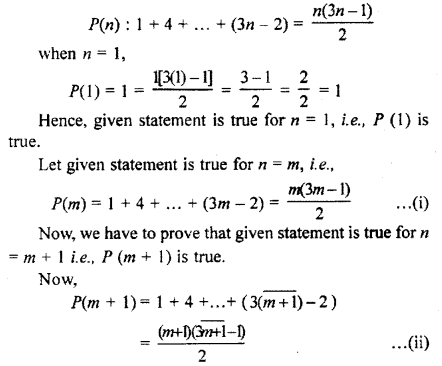
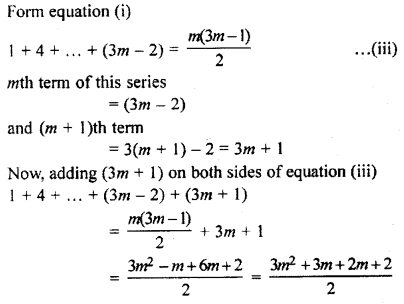
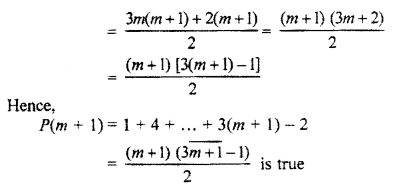
Hence, by principle of mathematical induction given statement is true for each n.
Hence Proved.
Question 7.

Solution:
Let the given statement is P(n), where n ∈ N
P(n) = 1.3 + 3.5 + 5.7 +……+ (2n – 1)(2n + 1)
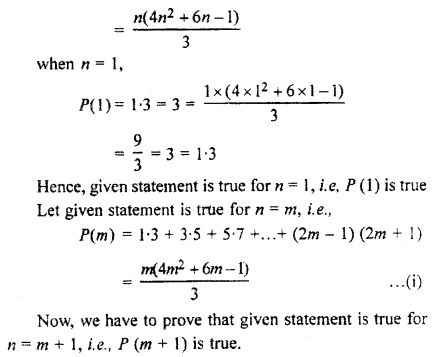
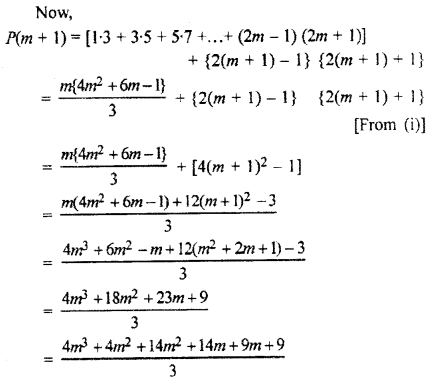
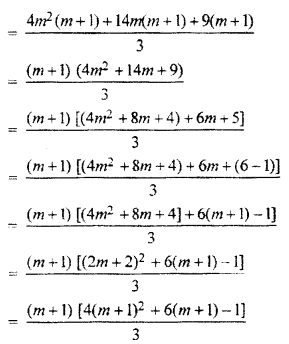
Hence, given statement is also true for n = m + 1 i.e., P (m + 1) is true.
Hence, by the principle of mathematical induction we can say that the given statement is true for each natural number n ∈ N.
Hence Proved.
Question 8.
1.3 + 2.4 + ……. + n(n + 2) = \(\frac { n(n+1)(2n+7) }{ 6 }\)
Solution:
Let the given statement is P(n), where n ∈ N
So, P(n) = 1.3 + 2.4 + ……. + n(n + 2)
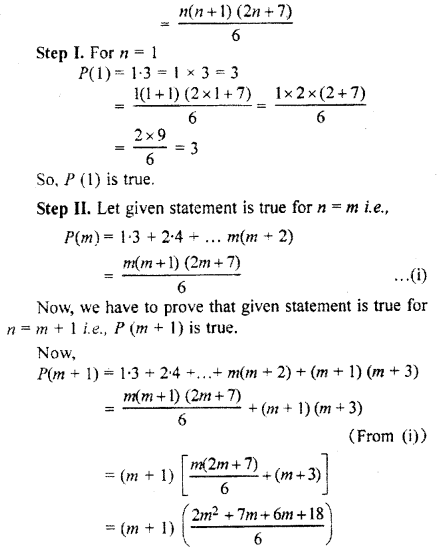
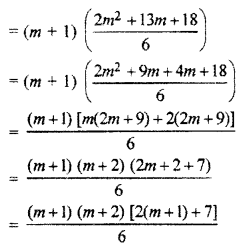
Hence, P(m + 1) is true.
Hence, by the principle of mathematical induction, we can say that the given statement is true for each natural number n ∈ N.
Hence Proved.
Question 9.
1.2.3 + 2.3.4 + …… + n(n + 1) (n + 2) = \(\frac { n(n+1)(n+2)(n+3) }{ 4 }\)
Solution:
Let given statement is P(x) where n ∈ N. i.e.,
P(n) = 1.2.3 + 2.3.4 +………+ n(n + 1)(n + 2)
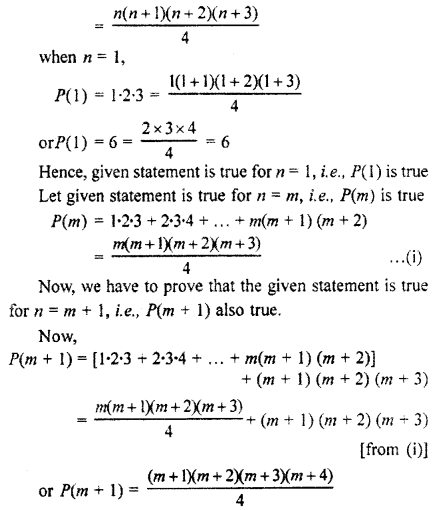
Hence, the given statement is also true for n = m + 1, i.e, P(m + 1) is also true.
Hence, by the principle of mathematical induction.
We can say that the given statement is true for each natural numbers n ∈ N.
Hence Proved.
Question 10.

Solution.
Let given statement is P(n) where n ∈ N i.e.,
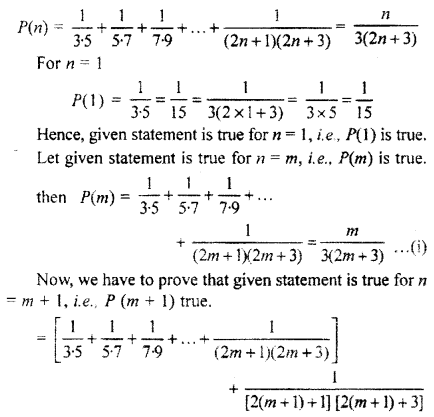
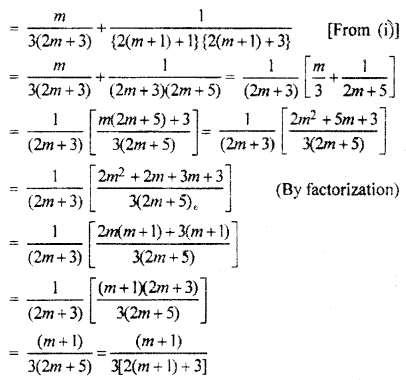
Hence, given statement is also true for n = m + 1, i.e., P(m + 1) is true.
Hence Proved.
Question 11.

Solution.
Let the given statement is P(n) when n ∈ N
i.e., P(n) = 13 + 23 + 33 + ……. + n3 = \(\left[ \frac { n(n+1) }{ 2 } \right] ^{ 2 }\)
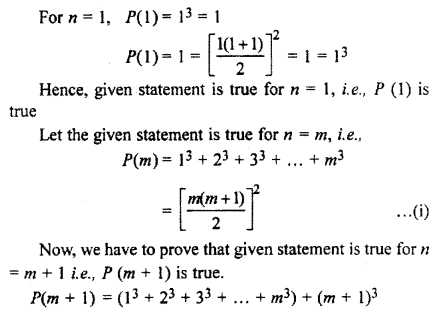
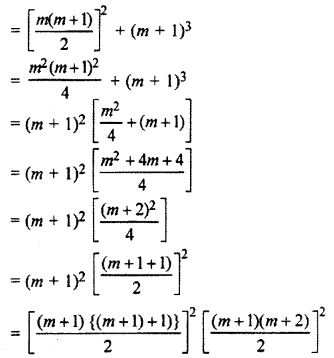
Here, given statement is also true for n = m + 1, i.e., P(m + 1) is also true.
Hence, by the principle of mathematical induction, we can say that the given statement is true for each natural number n ∈ N.
Hence Proved.
Question 12.

Solution:
Let the given statements is P(n), where n ∈ N,
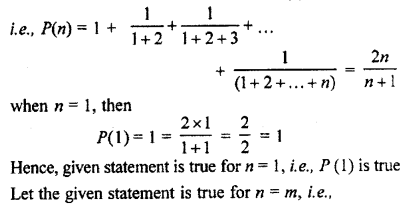
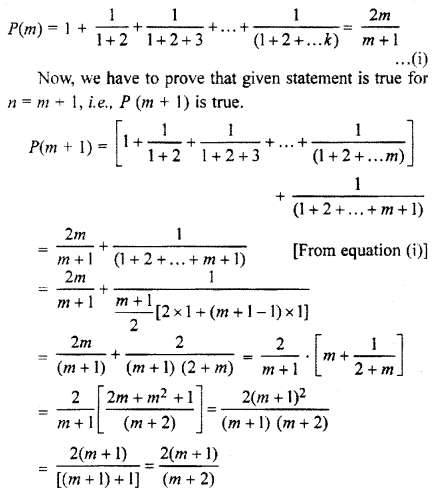
Hence, the given statement is true for n = m + 1, i.e., P (m + 1) is true.
Hence, by the principle of mathematical induction we can say that the given statement is true for each natural number n ∈ N.
Hence Proved.
Question 13.

Solution:
Let the given statement is P(n), i.e.,
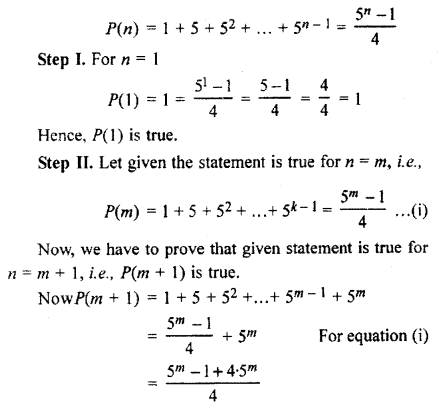
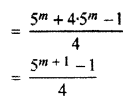
Hence, P(m + 1) is also true.
Hence, by the principle of mathematical induction the given statement is true for each natural number n ∈ N.
Hence Proved.
Question 14.

Solution:
Let the given statement is P(n), where n ∈ N.
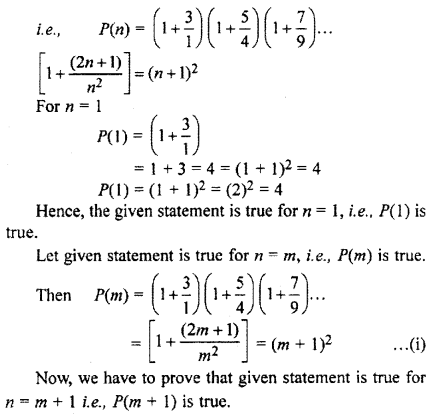
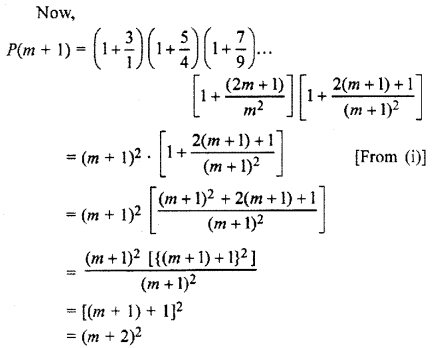
Hence, the given statement is also true for n = m + 1, i.e., P(m + 1), is true.
Hence, by the principle of mathematical induction, we can say that the given statement is true for each natural number n ∈ N.
Hence Proved.
Question 15.

Solution:
Let the given statement is P(n), where n ∈ N,
When n = 1, then
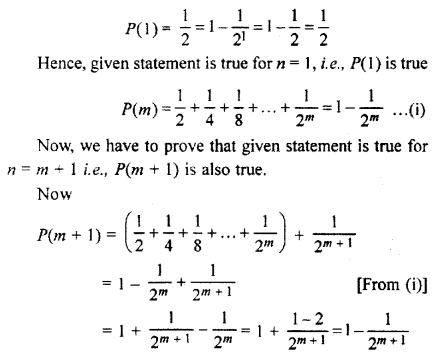
Hence, the given statement is also true for n = m + 1, i.e., P(m + 1), is true.
Hence, by the principle of mathematical induction, we can say that the given statement is true for each natural number n ∈ N.
Hence Proved.
Question 16.

Solution:
Let the given statement is P(n), where n ∈ N
P(n) = 1.3 + 2.32 + 3.33 + … + n.3n
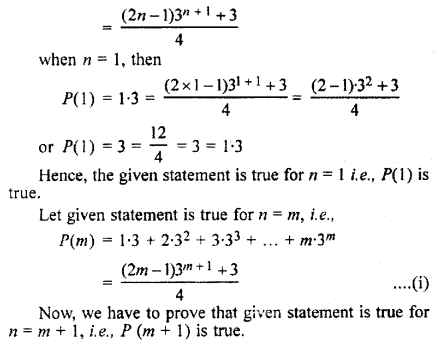
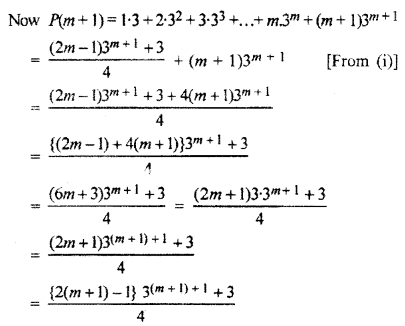
Hence, the given statement is also true for n = m + 1, i.e., P(m + 1) is true.
Hence, by the principle of mathematical induction, the given statement is true for each natural number n ∈ N.
Hence Proved.
Question 17.
2n > n
Solution:
Let P(n); 2n > n
when n = 1, 21 > 1, Hence, P(1) is true.
Let P(m) is true for n = m, i.e.,
P(m) : 2m > m ……(i)
Now, we have to proved that the given statement is also true for n = m + 1 i.e., P(m + 1) is true
Multiplying by 2 on both sides of equation (i), we have
2 × 2m > 2m
⇒ 2m+1 > 2m = m + m > m + 1
Thus, P(m + 1) is true.
Hence, by the principle of mathematical induction, P(n) is true for each natural number n ∈ N.
Hence Proved.
Question 18.
(1 + x)n ≥ 1 + nx, x > 0
Solution:
Let P(n) : (1 + x)n ≥ (1 + nx), x > 0
when n = 1 then P(n) is true
⇒ (1 + x) ≥ (1 + x) is true for x > -1 …(i)
For n = k
P(m) : (1 + x)m ≥ (1 + mx), x > 0 is true …(ii)
Now, we have to prove that P(m + 1)
We have that
(1 + x)m+1 = (1 + x)m (1 + x)
Given x > 0, So, (1 + x) > 0
Hence, using
(1 + x)m ≥ (1 + mx)
we get (1 + x)m+1 ≥ (1 + mx)(1 + x)
i.e., (1 + x)m+1 ≥ (1 + x + mx + mx2) …..(iii)
Since, m is a natural number and x2 ≥ 0 is such that
mx2 ≥ 0
So, (1 + x + mx + mx2) ≥ (1 + x + mx)
⇒ (1 + x)m+1 ≥ (1 + x + mx)
⇒ (1 + x)m+1 ≥ [1 + (1 + m)x]
Since, statement (ii) is true.
Hence, by the principle of mathematical induction P(n) is true for each natural number n ∈ N.
Hence Proved.
Question 19.
1 + 2 + 3 + ……. + n < \(\frac { 1 }{ 8 }\) (2n + 1)2.
Solution:
Let the given statement is P(n), where n ∈ N,
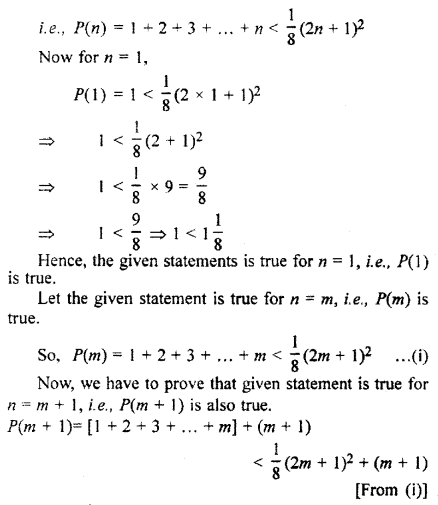
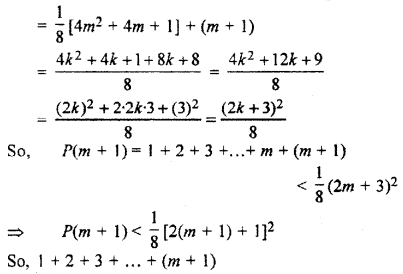
< \(\frac { 1 }{ 8 }\) [2(m + 1) + 1]2
Hence, the given statement is also true for n = m + 1 i.e., P(m + 1) is also true.
Hence, from the principle of mathematical induction we can say that the given statement is true for each natural number n ∈ N.
Hence Proved.
Question 20.
Prove that x2n – y2n is divisible by (x + y).
Solution:
Let the given statement is P(n), where n ∈ N
P(n) = x2n – y2n
For n = 1, P(1) = x2 – y2 = (x + y) (x – y),
which is divisible by (x + y)
Hence, given statement is true for n = 1, i.e., P(1) is true.
Let the given statement is true for n = m, i.e., P(m) is true.
Then P(m) = x2m – y2m is divisible by (x + y) ……(i)
Now, we have to prove that given statement is true for n = m + 1, i.e., P(m + 1) is true.
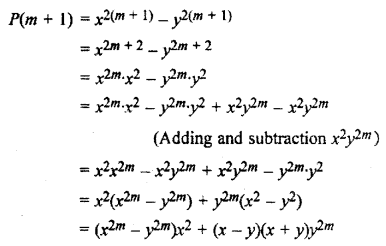
Now, we see that there are two terms in R.H.S.
In first term (x2m – y2m), which is divisible by (x + y) [From (i)]
and second term is also divisible by (x + y) because (x + y) is its factor.
Then sum of both terms is also divisible by (x + y).
Hence, the given statement is also true for n = k + 1, i.e., P(m + 1) is true.
Hence, by the principle of mathematical induction we can say that the given statement is true for each natural number n ∈ N.
Hence Proved.
Question 21.
Prove that 23n – 1 is divisible by 7.
Solution:
Statement P(n) : 23n – 1 is divisible by 7
i.e., 23n – 1 = 7n
For n = 1, P(1)= 23(1) – 1 = 7 is divisible by 7
Hence, given statement is true for n = 1, i.e., P(1) is true.
Let P(m) is true, i.e. 23m – 1 = 7m ……(i)
Now, we have to prove that given statement is also true for n = m + 1 i.e.. P(m + 1) is true
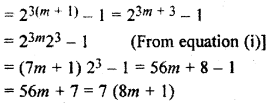
i.e., 23(m+1) – 1, is divisible by 7.
⇒ P(m + 1) is true.
Hence, the given statement P(n) is true for each value of n.
Hence Proved.
Question 22.
Prove that: 10n + 3.4n+2 + 5, is divisible by 9.
Solution:
Let the given statement
P(n) = 10n + 3.4n+2 + 5 is divisible by 9.
For n = 1,
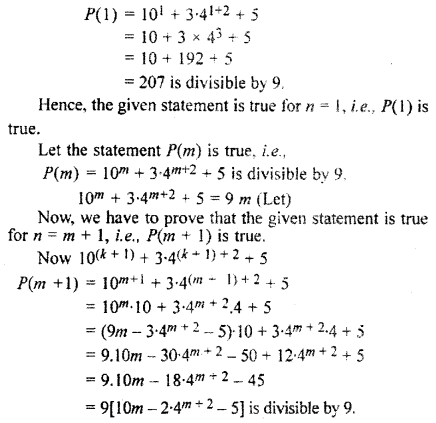
Hence, the given statement is true for n = m + i, i.e., P(m + 1) is true.
Hence, P(n) is true for each natural number n ∈ N.
Hence Proved.
Question 23.
Prove that : 41n – 14n is divisible by 27.
Solution:
Let the given statement is P(n) where n ∈ N,
i.e. P(n)= 41n – 14n is divisible by 27
For n = 1, P(1) = 411 – 141 = 41 – 14 = 27
which is divisible by 27
Hence, given statement is true for n = 1, i.e., P( 1) is true
Let given statement is true for n = m i.e., P(m) is true
Then P(m) = 41m – 14m, is divisible by 27 ……(i)
Now, we have to prove that given statement is true for n = m + 1, i.e., P(m + 1) is also true
Now,
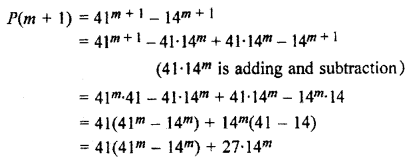
Here, there are two terms in R.H.S. In first term (41m – 14m) is divisible by 27 [From (i)] and second term is also divisible by 27 because 27 is its one factor.
Then sum of both terms is also divisible by 27.
Hence, the principle of mathematical inducation, we can say that the given statement is true for each natural numbers n ∈ N.
Hence Proved.
Question 24.
Prove that (2n + 7) < (n + 3)2, ∀ n ∈ N.
Solution:
Let the given statement is P(n) where n ∈ N
P(n) = (2n + 7) < (n + 3)2
For n = 1, P(1) = (2 × 1 + 7) = 9 < (1 + 3)2 = 16,
9 < 16
Hence, given statement is true for n = 1, i.e., P(1) is true.
Let given statement is true for n = m. i.e., P(m) is true.
Then P(m) = (2m + 7) < (m + 3)2
Now, we have to prove that given statement is true is true for n = k + 1 i.e., P(m + 1) is true.
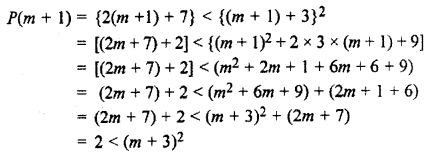
Hence, the given statement is also true for n = m + 1, i.e., P(m + 1) is true.
Hence, by the principle of mathematical inducation we can say that the given statement is true for each natural number n ∈ N.
Hence Proved.
Question 25.

Solution:
Let the given statement is P(n), where n ∈ N

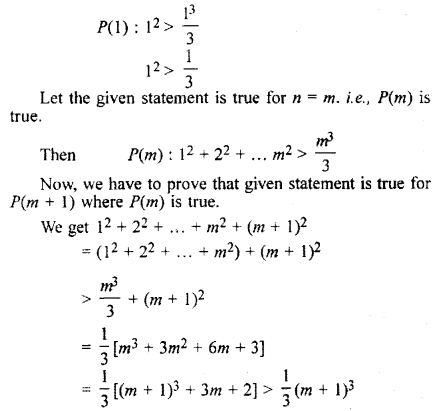
Thus, P(m + 1) is true, when P(m) is true.
Hence, by the principle of mathematical induction, P(n) is true for n ∈ N.
Hence Proved.